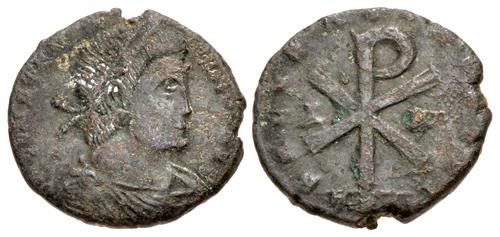
|
Constantius II. AD 337-361. Æ Centenionalis (22mm, 6.71 g, 6h). Treveri (Trier) mint, uncertain officina. Struck AD 353.
Electronic Auction 485
Lot: 612. Estimated: $ 200
Roman Imperial, Bronze
Sold For $ 300. This amount does not include the buyer’s fee.
Go to Live
|
|
Constantius II. AD 337-361. Æ Centenionalis (22mm, 6.71 g, 6h). Treveri (Trier) mint, uncertain officina. Struck AD 353. Pearl-diademed, draped, and cuirassed bust right / Large Chi-Rho; A ω flanking; T[...]. RIC VIII 332; LRBC 67. Brown and green surfaces, some minor pitting. Near VF. Very rare.
Several numismatists have tried to associate this coin, combining an obverse of Constantius II and a reverse type of the usurpers Magnentius and Decentius, with a tantalizingly obscure passage from the fourth-century historian, Ammianus Marcellinus. There, the historian, relating the clean-up of Magnentius' revolt, mentions the killing of a Poemenius who revolted against the usurpers in Trier and handed the city over to the legitimate emperor, Constantius II. While J.P.C. Kent (NC 1959, pp. 105-108) asserted these coins, as well as a contemporary gold issue, were struck by Poemenius in anticipation of the emperor's retaking of the city, P. Bastien (QT 1983), revisited the question. Re-analyzing the gold issue, he concluded that the bronze coins were issued only after Constantius had retaken the city, and not before. More recently, W. C. Holt (AJN 15 [2004]), while arguing with slight modifications, nevertheless agrees in genere with Kent's hypothesis. Although this coin is clearly associated with the events of the revolt in Trier, any more certain conclusion at this point remains based on how one wishes to interpret the scant evidence.
One unanswered question remains: for what reason was a reverse type so closely associated with the usurpers used in combination with a legitimate obverse of Constantius? The political use of Christian symbolism became much more visible during the latter stages of Magnentius' revolt. His use of the Chi-Rho reflects a similar one of Vetranio: the emperor (either Vetranio himself, or Constantius II) holding a labarum, and the legend IN HOC SIGNO VICTOR ERIS, a statement associated with the vision of Constantine I on the night before has battle with his rival, Maxentius. In the present case, it is quite possible that the forces of Constantius II in Trier briefly co-opted the symbology of the usurpers, adding the legend of the legitimate emperor to parallel the ultimate victory of Constantius II with that of his father.
Closing Date and Time: 10 February 2021 at 13:23:40 ET.
All winning bids are subject to an 18% buyer’s fee.
|
